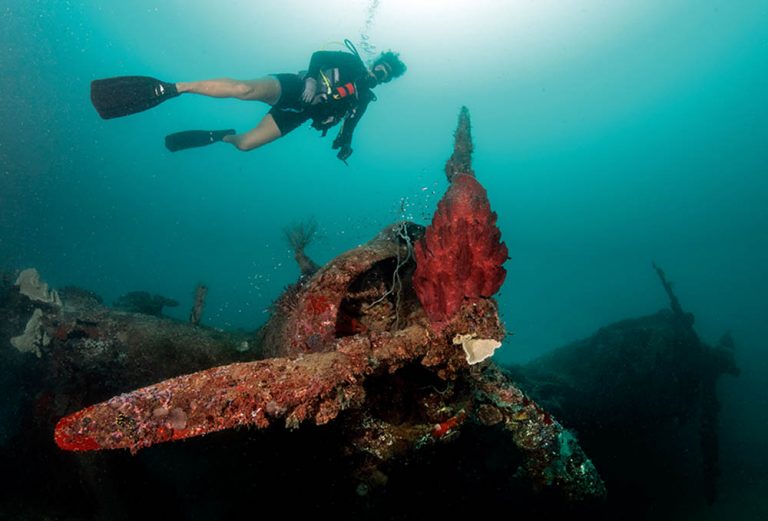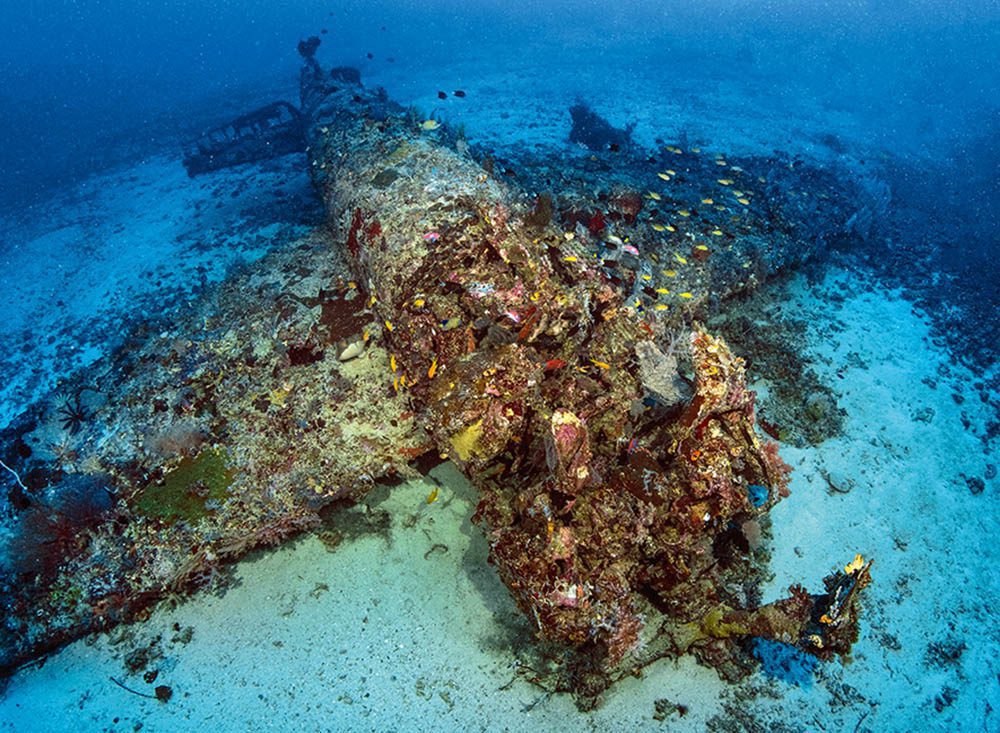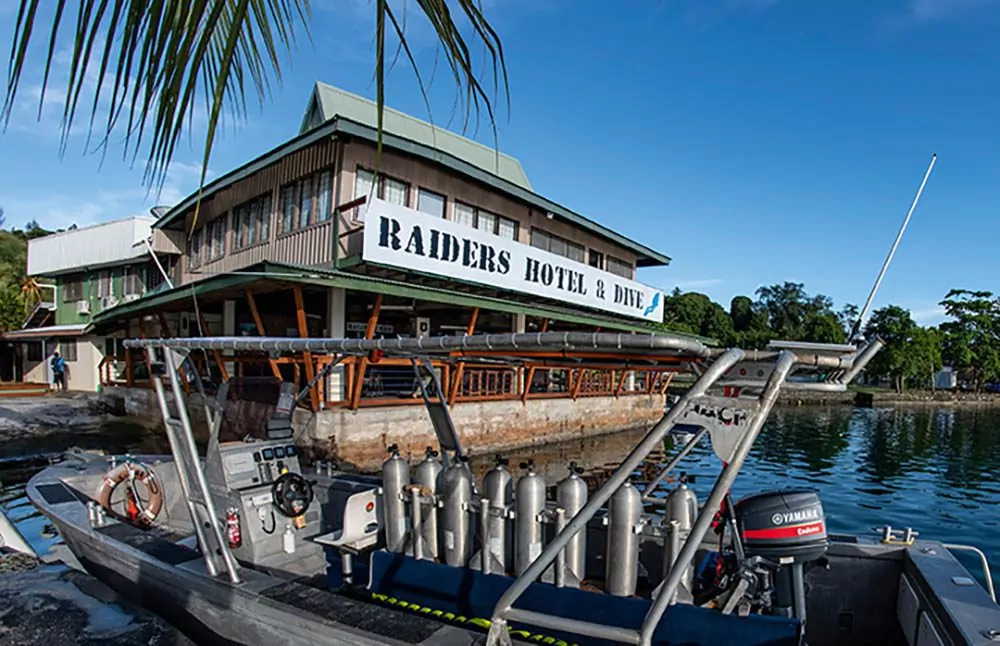SOLOMONS DIVER
In the January edition we left MARK B HATTER heading onward after the first leg of his Solomon Islands adventures but feeling distinctly unwell. Had the curse of Skull Island claimed a victim?
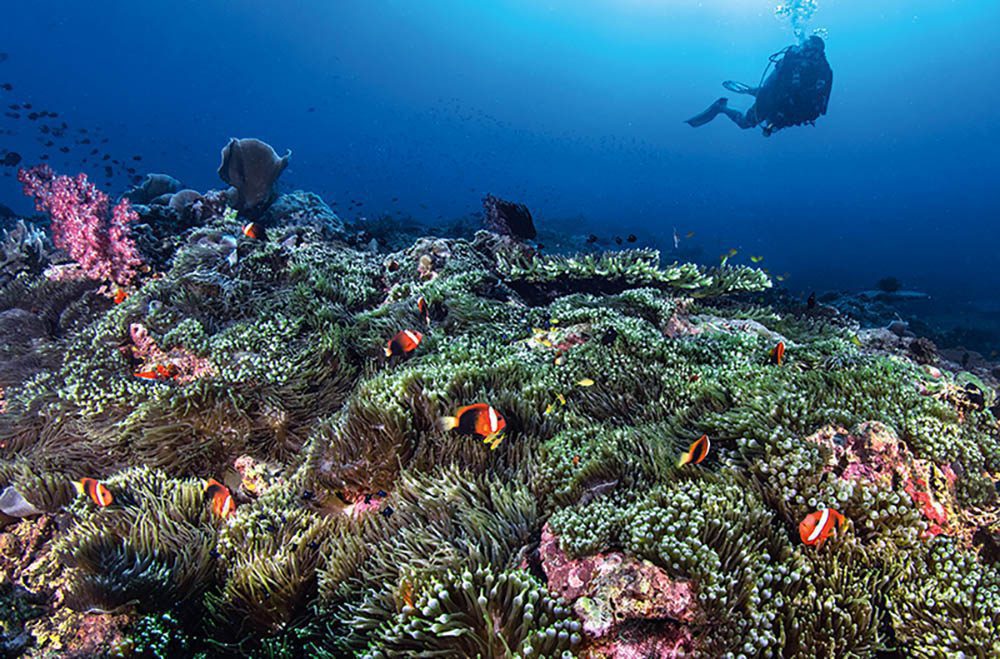
A diver’s worst nightmare while on a diving holiday is succumbing to some malady that inherently puts a stop to diving for the rest of the trip. This was exactly my predicament midstream on a recent visit to the Solomon Islands.
I was halfway through an incredible experience, having completed a week of reef-, wreck- and wall-diving in the crystalline, pristine waters of Munda in the Western Province, and on my way to a week’s worth of diving out of Tulagi in the Eastern Province Florida Islands, when I hit a health speed bump.
A big one, and one that might have been the result of my own unwitting irreverence to ancestral spirits at the sacred burial ground on Skull Island.
The tribes of the Solomon Islands, particularly in the Western Province, were fond of taking the heads of enemies to ensure that tamu garata (good juju) would prevail over them.
They also believed that keeping the heads of their deceased tribal leaders enabled their eternal afterlife. The practice of head-hunting continued until the early 20th century, when missionaries arrived to impose Western “influence” on what they called “these primitive cultures”.
Fearing that the Westerners would destroy their revered, centuries-old tradition of skull-keeping, the people moved their leaders’ skulls from local villages to Skull Island,
a remote, sacred location where the chieftains could reign in perpetuity in the afterlife. Which, possibly, is where my medical calamity began.
On my no-dive air-travel day from Munda back to Honiara I had taken a water-taxi with an Australian journalist and Barbara, a representative from the Solomon Islands Tourism Bureau, to visit the sacred shrines on Skull Island. Barbara had told us that ancient lore barred women from visiting the shrines, leaving her uneasy about our trip.
But we did it, assured by our panga-driver that we had spiritual permission after his requisite incantation before allowing us to step off the boat. I got my images, and brushed off Barbara’s continued apprehension that “something bad was going to happen”.
Later that day my right ear began to ache, going quickly off the charts.
I managed the one-hour flight to Honiara that afternoon without my head imploding, but was in dire need of medical help, even after self-medicating the ear with a concoction of crushed-up antibiotics in a solution of alcohol and vinegar for most of the night.
And I might have written this off to coincidence had it not been for the compounding of additional problems, including the death of my mobile phone (for no apparent reason) coupled with a case of fever, chills and intestinal distress.
Did I somehow insult the spirits on Skull Island? I’m not particularly superstitious but I figured it couldn’t hurt to make my apologies to the deceased chieftains for any perceived faux pas, and thank them for the privilege of capturing their images in their shrines. Which I did with gusto.
Coincidence again? The severe ear pain, fever, chills and stomach issues abated quickly after breakfast and my act of contrition, leaving me only with a dead phone and near-deafness in my right ear.
Regardless of my improved condition,
I had time before my 10am boat-trip to Tulagi in the Florida Islands for a pit-stop at a Honiara clinic, where the medical attendant confirmed my ear infection.
He prescribed internal and external antibiotics, then issued me a strict warning: “No diving for at least a week.”
As I walked out of the clinic, meds in hand, pain-free but unable to hear from one ear and more than worried, I heard myself say: “Yeah, like that’s gonna happen.” A week sitting in a hotel room in the beautiful and historically storied Florida Islands? No way…
The Florida Islands archipelago lies north of Guadalcanal Island on the opposite side of Iron Bottom Sound (Savo Sound before WW2) – so named by Allied sailors for the stretch of water between Guadalcanal, Savo Island and the Florida Islands in which dozens of ships and planes sank during the Battle of Guadalcanal in 1942–43.
The mountainous archipelago includes two main isles, Nggela Sule (Florida Island) and Nggela Pile (to the south), plus several smaller ones, the largest of which are named Tulagi, Gavutu and Tanambogo.
While dive-sites around Munda in the Western Province are largely defined by the inner and outer reef structures surrounding the massive Roviana lagoon, sites around the Florida islands are characterised more by offshore bommies and fringe reefs surrounding the islands, often with plunging walls. There is also a plethora of Allied and Japanese WW2 plane wrecks all around the islands.
Tulagi was a significant Japanese stronghold before the Battle of Guadalcanal, with land-based garrisons and a seaplane port between Gavutu and Tanambogo Islands leaving historic wreckage everywhere within a stone’s throw of diving operations at Raider’s Hotel & Dive. This centre was named after the US Marines 1st Raider Battalion, commanded by Lt-Col Merritt A Edson and known as Edson’s Raiders, on Tulagi.
It’s this history, the tropical climate and the spectacular diving on the edge of the Coral Triangle, the epicentre of marine biodiversity, that brings divers like me to the Florida Islands.
My water-taxi for the one-hour trip to Tulagi turned out to be the large, comfortable, fast boat from Raider’s Hotel & Dive from which I had been diving.
As we cast off from the dock in Honiara I explained my medical problem to Raider’s owner-operator Bob Norton, who suggested a test dive after checking in to see if I could manage.
I survived that dive, at a site called Twin Tunnels, and was easily able to clear my ears without issue. I even got to shoot some images with my macro kit.
I was now looking forward to exploring those WW2 aircraft wrecks and reefs, mostly minutes from Raider’s dock, for the balance of the week.
And with regard to that check-out dive (it was slow to occur to me thanks to my preoccupation with ear-clearing), Twin Tunnels was phenomenal!
Only 10 minutes from Raider’s dock, the reef is a large, flat-top volcanic pinnacle, rising from the deeper sound with a pair of ancient lava-tubes roughly in the centre of the reef-top at 15m. The tubes drop nearly vertically, exiting along a plunging wall at 36m. They were cool, but I was particularly blown away by the numbers and density of anemones with families of anemonefish atop the reef.
Over a bowl-shaped depression near the tunnels, as I hovered a few metres above the reef, I counted more than a dozen anemone colonies represented by five species within my circle of vision. This site is special, and we observed the liveaboard Bilikiki spending a day at the site later in the week.
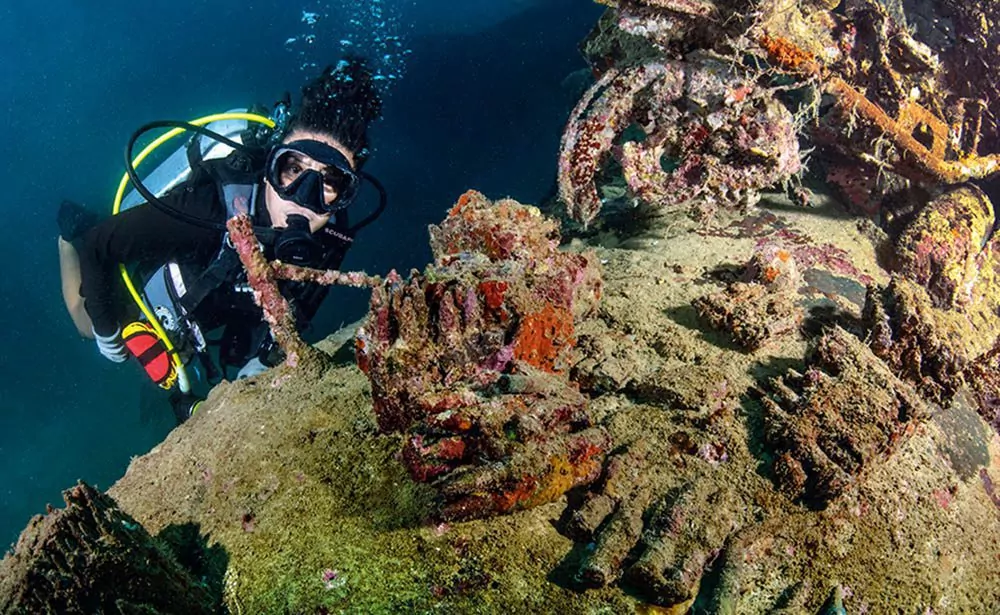
Back at the hotel and finally able to relax, I ordered a beer and rested elbows on the deck railing, overlooking a small house-reef below. I had counted 11 giant clams when Bob ambled up, announcing: “Dinner is served!” Then he added: “Tomorrow we’ll dive two plane wrecks – an American Catalina between 24 and 31m and a pair of Japanese Kawanashi Mavis 1 seaplanes off Gavutu Island, between 25 and 32m.”
If you’re a wreck buff, particularly if you’re into aviation wrecks, the plane relics around Tulagi should be added to your diving bucket-list. We dived the Catalina before breakfast.
The historical record suggests that it was heavy with cargo at take-off and experienced problems during climb-out. Unable to maintain lift, it crash-landed shortly after take-off, killing one passenger though the crew survived.
The seaplane rests upright with its fuselage, wings and engines intact; great for wide-angle imagery. Medium-calibre munitions can be found on the left wing, below the gunner’s cupola, a reminder that this aircraft and the others of the time were armed with deadly force.
As the wreck is close to shore, in the sound between Tulagi and Gavutu, the bottom is silty and care must be taken not to stir it up – all of which adds to the allure of diving historic relics.
Until now, all the wrecks I had dived in the Solomon Islands (including those in Munda) had been US planes. So I looked forward to diving the Mavis seaplanes, sunk at anchor during an Allied naval bombardment of the Japanese base during the Battle of Tulagi and Gavutu-Tanambogo.
The Mavis were impressively large, multi-engine seaplanes and rested upright on the silty bottom, very much intact. They were sunk rather ingloriously, rather than being shot from the sky, but their history and aluminum “bones” are no less glorious for that.
Later in the week, Bob suggested a wall-dive off Nanjalakaulau Island. With the wind nearly calm, the weather was excellent for the hour-long run to the dive-site. We packed a hearty lunch and left early on a smooth sea. About 40 minutes into the run north, Bob slowed the boat and offered a new option.
“About three weeks ago, two WW2 relic researchers I’ve been working with approached me regarding a possible new airplane wreck at Maravagi Passage, close to the walls we’d planned to dive,” he explained.
“As they were fluent in some of the island languages the researchers talked to locals about the rumoured wreck and commissioned me to help find the plane.”
“Incredibly, we found the wreck quickly – a Navy F4F-4 Wildcat, at 37m, right where the villagers said it had gone down more than 70 years ago,” said Bob.
An offer to be the first photographer to catalogue a wreck-site doesn’t come along every day. Of course I’d ditch a wall-dive for this opportunity to be, literally, the fourth diver beyond the researchers, Bob and his wife, to dive this relic!
Bob recalled his triangulation points from memory, and we slipped into the water but misjudged the current.
Reaching the bottom, we clawed our way upcurrent for perhaps 50m before the fighter, lying intact upside-down, materialised into view. Lying in a passage with strong currents, visibility was excellent, with no silt.
Time was short, and we worked together to capture the best angle to portray this rare discovery before having to work our way back to the shallows along a beautiful fringe reef at the edge of the passage channel.
Back aboard the boat we celebrated with fist-bumps, ate granola bars and hydrated while idling at a nice, slow off-gassing pace to our wall-dive site along Nanjalakaulau Island.
The wall-diving at the northern end of the archipelago was impressive, as I would expect, with the full cast of characters from reef sharks to giant seafans, yet I couldn’t stop thinking about spending my last dive of the trip back at Twin Tunnels. I wanted to go back with my wide-angle kit, knowing the shots I wanted.
“Not a problem!” Bob assured me. “We’ll end the trip with an early-morning dive at Twin Tunnels before we shuttle back to Honiara.”
Next morning, again on a smooth sea, we slipped into the water to find excellent visibility and a moderate current. Bob worked with me and modelled well at the mouth of one of the tunnels while I silhouetted him from below.
Reviewing my images through the housing, I was pleased with a couple of shots and swam out to shoot the vast bulb-tip anemone forest I recalled from my first dive. It was a fitting end to the second chapter in my Solomon Islands holiday.
PostscrIpt: My hearing remained impaired for four weeks following the trip. In retrospect, the medical issues were simply random incidents, not a curse from malevolent spirits.
No, considering the possible dire circumstances of diving with an ear infection, I am now more than convinced that the ability to clear my ears, while diving, and without pain, was based on the gracious intervention of the benevolent spirits of Skull Island; they wanted to share with me their nation of riches, more valuable than gold!
FACTFILE
GETTING THERE
Brisbane, Australia is the gateway city to the Solomon Islands. Solomon Airlines flies direct from there to Honiara and the resort will arrange boat transfers to Tulagi.
Diving & ACCOMMODATION
Raider’s Hotel & Dive offers three dives a day, raidershotel.com
WHEN TO GO
Rainy season is November-January but it usually just showers. There is always a lee site to dive if the wind blows.
HEALTH
A recompression chamber in Honiara is manned by volunteers but not always available – the next is 1500 miles away in Townsville, Australia.
PRICES
Return flights from London around £1200. Three-tank excursion with breakfast, lunch and dinner with a single room at Raiders Hotel & Dive costs £210 a day.
